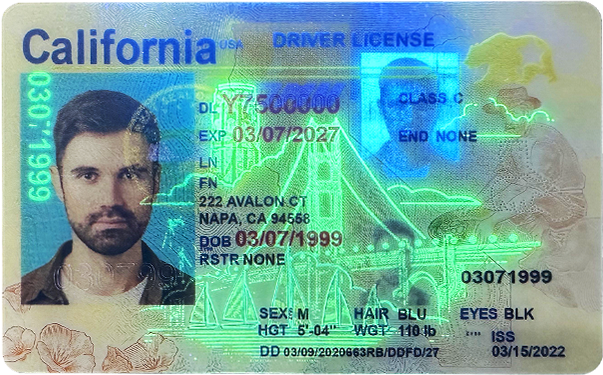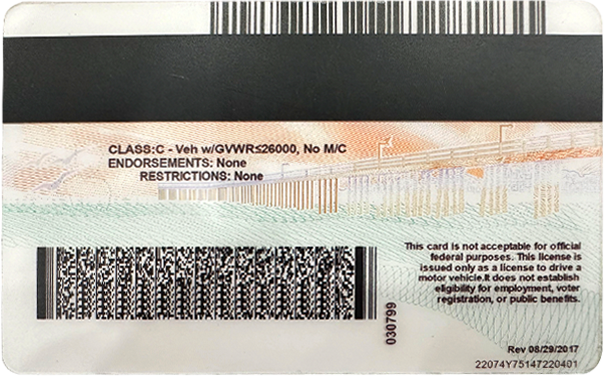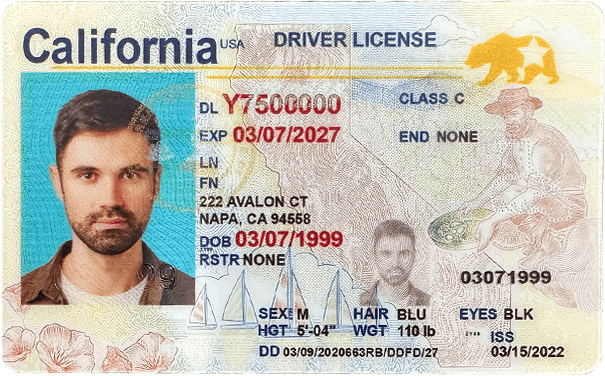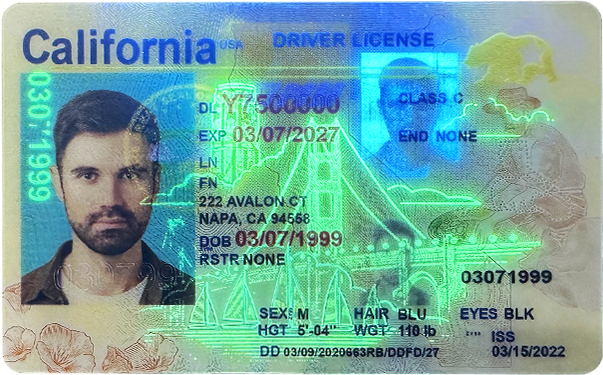A California fake ID is a counterfeit version of the state-issued driver’s license or identification card designed to look like the real thing. It’s used primarily by underage individuals attempting to pass age restrictions or by people seeking to obscure their real identity. With California being one of the strictest states when it comes to ID verification—thanks to its thriving nightlife, strict cannabis and alcohol laws, and tech-savvy businesses—fake IDs are surprisingly common. But what exactly is a California fake ID, and why do so many people risk getting one?
Understanding What a California Fake ID Is
At its core, a California fake ID is an illegal reproduction of the official ID issued by the California Department of Motor Vehicles (DMV). These IDs are not authorized by any government agency and are manufactured by individuals or criminal enterprises using various tools and technologies. The purpose? To trick scanners, security personnel, and businesses into believing the user is someone they’re not.
Fake California IDs are among the most replicated in the U.S. because of their complexity, popularity, and demand. They often attempt to replicate key features like the ghost image, holograms, laser-perforated bear symbol, UV elements, and a magnetic barcode on the back.
The latest real California IDs, known as REAL ID-compliant cards, include even more security layers such as a gold bear with a white star. Fake ID makers attempt to copy these too, but most fall short when scrutinized by trained eyes or scanning technology.
How California Fake IDs Are Made
Creating a fake ID is not as simple as printing something off on a color printer. Modern fake ID producers use high-end printers, laminate techniques, specialized software, and digital templates. Some even operate in full-scale illegal print labs using state-of-the-art technology.
There are two primary sources for fake IDs: domestic producers (often individual sellers operating on social media or Discord) and international producers (primarily from China or Eastern Europe) who advertise on the dark web or encrypted messaging platforms. The foreign market usually provides more advanced holograms and barcodes but comes with increased risks of scams and customs seizure.
Some fake ID operations even allow customization—letting users upload their own photo, choose name and address details, and even add scannable barcodes that match their fake birthdates. The goal is to create something that not only looks real but functions real when scanned or inspected.
Why People Buy California Fake IDs
The reasons behind using a California fake ID vary by age group, region, and intent. For some, it’s a rite of passage. For others, it’s a calculated move to sidestep regulations. Let’s dive into the common motivations.
Underage Drinking and Clubbing
Perhaps the most well-known reason people buy fake IDs is to buy alcohol or access clubs, bars, and music events that require patrons to be 21 or older. In a nightlife-heavy state like California, with hotspots like Los Angeles, San Francisco, San Diego, and Hollywood, the social pressure to get into 21+ venues is intense. College students often share fake ID tips in dorms and Reddit threads to stay ahead of detection.
Buying Tobacco, Vapes, and Cannabis
California law prohibits the sale of tobacco products, e-cigarettes, and recreational marijuana to anyone under 21. That includes popular THC vape pens, CBD oils, and pre-rolls sold in dispensaries. To bypass this, many teens and young adults turn to fake IDs. Dispensaries are required to check identification at the door, and some users rely on counterfeit IDs to sneak through.
Casino Gambling
Tribal casinos throughout California, like Pechanga or Morongo, offer slot machines, poker, and blackjack—but only to players 21 and older. Some underage adults use fake IDs to gamble or enter casinos where alcohol is served. Since casinos usually use high-grade scanners and face-recognition tech, this is a high-risk use of fake IDs, but people still attempt it.
Hotel Check-Ins and Car Rentals
Some hotels and rental services require the guest to be at least 21 or even 25. A fake ID can be used to fake eligibility, especially when renting cars, checking into hotels for events, or booking Airbnbs that have age restrictions in their terms.
Bypassing Age Restrictions on Apps or Online Platforms
Some websites and social platforms ask users to confirm they are 18 or older to access certain content. Fake IDs are sometimes used as “proof” when age verification goes beyond a simple checkbox. This might include dating apps, adult content platforms, or online delivery services for alcohol.
Employment or Identity Fraud
On the darker side, fake IDs are used to falsify employment applications or background checks. Undocumented workers or individuals with criminal records might use fake California IDs to pass job screenings. This veers into federal offense territory and can lead to severe legal consequences.
The Legal Risks of Using a California Fake ID
Using, possessing, or producing a fake ID in California is illegal under several laws, including California Penal Code 470b, which specifically prohibits possessing a forged government-issued ID with intent to use it fraudulently.
Getting caught with a fake ID can result in:
-
A misdemeanor charge punishable by up to 1 year in jail and a fine up to $1,000
-
A felony charge (in cases involving identity theft or fraud), leading to prison time
-
A permanent criminal record that could affect student loans, job prospects, and more
-
Driver’s license suspension, even if the fake ID wasn’t used for driving
Colleges and universities also have strict disciplinary actions in place. Students caught with fake IDs could face suspension, academic probation, or expulsion.
How Fake California IDs Are Detected
With the rise of digital ID verification tools, it’s harder than ever to get away with using a fake ID in California. Many clubs, dispensaries, and casinos use handheld scanners that read the barcode on the back of the card. If the barcode data doesn’t match the printed data—or if the barcode is missing altogether—it raises an instant red flag.
Security personnel are also trained to spot:
-
Incorrect font spacing
-
Pixelated holograms
-
Improper layering
-
Suspicious laminate edges
-
Anomalies under UV light
In high-security venues, AI-powered ID scanners and biometric facial recognition systems further increase detection. These tools match the face on the ID to the person presenting it in real-time.
Who Is Buying These Fake IDs?
The majority of fake ID buyers in California are college students and high school seniors, especially those in party-heavy areas like UCLA, UC Berkeley, or San Diego State. Students from other states also seek California fake IDs because of their design reputation—some believe California IDs are more likely to “pass” due to their complexity and realism.
There’s also a rise in international students seeking fake IDs to enjoy American social life, unaware that consequences could affect their visa status or academic standing.
Can You Really Tell a Fake ID Apart From a Real One?
From a casual glance, a well-made fake California ID may seem flawless. But under scrutiny, differences begin to show. Fake IDs often:
-
Use wrong fonts or spacing
-
Fail to replicate the UV security features
-
Show incorrect date formats or expiration timelines
-
Have mismatched physical feel (weight, bend, texture)
Even the most professional fake IDs usually break down under scanner checks or forensic examination.
The Dark Web Marketplace for Fake IDs
Buying a California fake ID is just a few clicks away if you know where to look. The dark web, accessed via encrypted browsers like Tor, is filled with vendors selling fake IDs in bulk. These marketplaces often operate with cryptocurrency payments, using stealth shipping techniques to avoid seizure by customs.
Prices vary. A high-quality California fake ID can cost anywhere between $100 to $250, with bulk discounts for groups. Some vendors offer “dupe packages” — a main ID and a backup copy — in case one gets confiscated.
However, it’s a risky market. Many buyers report scams, poor quality products, or never receiving their order. Customs officials also seize thousands of fake IDs every month entering California through international mail.
How Businesses Protect Themselves Against Fake IDs
Businesses in California face heavy fines if they serve minors or fail to verify age. To combat fake IDs, they invest in:
-
ID scanners that verify barcodes and magnetic strips
-
Training programs that help staff recognize fake IDs
-
AI-powered verification tools that analyze facial features and ID details
-
Third-party verification services for high-risk industries like cannabis or gambling
Nightclubs and dispensaries, in particular, are turning to technology-first approaches to avoid liability.
Final Thoughts: Is It Worth the Risk?
A California fake ID might seem like a simple way to gain adult privileges, whether it’s enjoying nightlife, buying weed, or entering casinos. But behind that plastic card lies a chain of legal, ethical, and financial consequences.
For some, it’s a gamble that ends in a ruined academic record, criminal charges, or financial scams. For others, it’s a gateway to more serious fraudulent behavior that could lead to federal charges.
The truth is: while the short-term thrill might be appealing, the long-term risk far outweighs the reward. With law enforcement, AI technology, and digital scanning tools getting better every year, fake IDs are easier to spot—and harder to get away with.
If you’re underage and tempted, think twice. California is one of the toughest places to pull off a fake ID without getting caught. And if you’re a business, make sure you’re equipped to catch fakes before they cost you everything.




